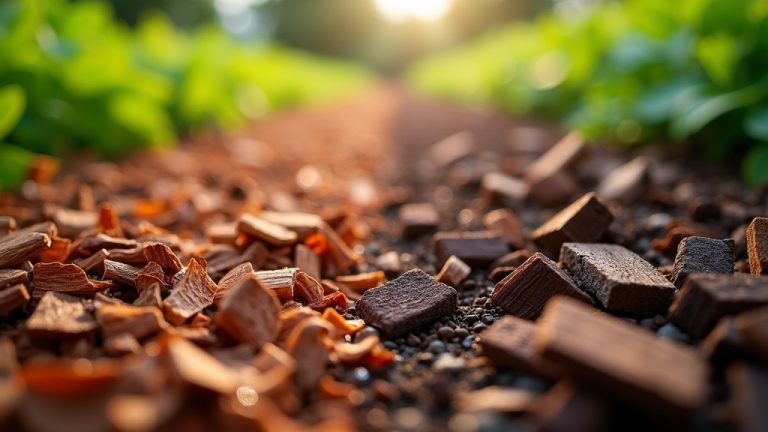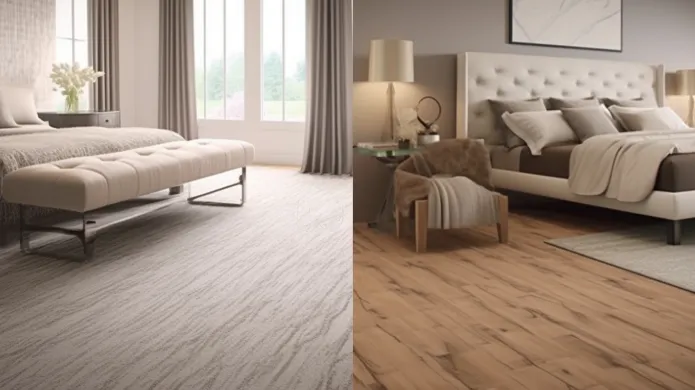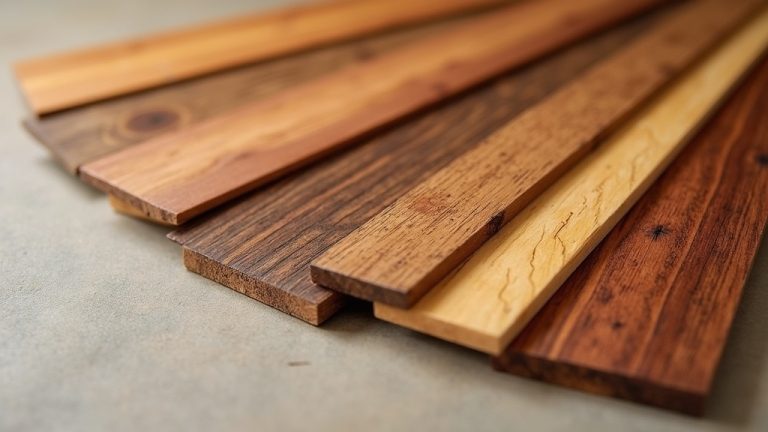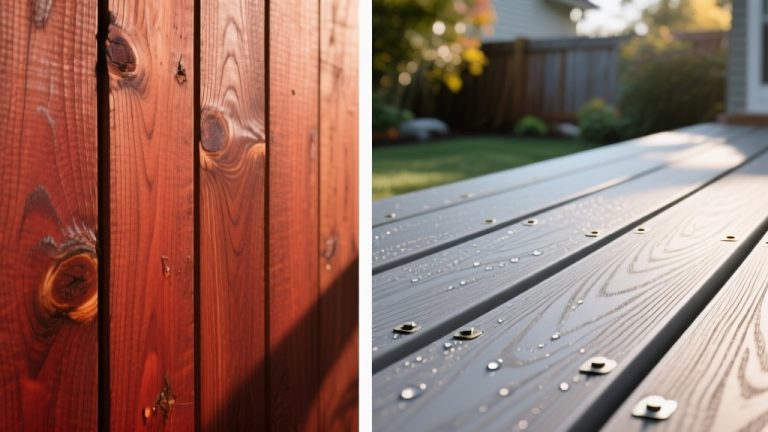Natural vs Stained Hardwood Floors: An In-Depth Comparison
If you’re considering installing or refinishing hardwood floors, one of the biggest decisions you’ll need to make is whether to go with a natural or stained finish. Both options have their pros and cons, and it’s important to understand the differences between them before making a final decision.
Natural hardwood floors showcase the wood’s innate beauty, highlighting its grain and patterns with a clear coat finish. On the other hand, stained hardwood floors provide a trendy and dramatic look, offering a wide range of stain colors to complement various decor styles.
Understanding the differences between natural and stained hardwood floors is essential in making an informed decision that aligns with personal taste and the overall aesthetic of the space. So let’s take a look.
The Differences Between Natural vs Stained Hardwood Floors
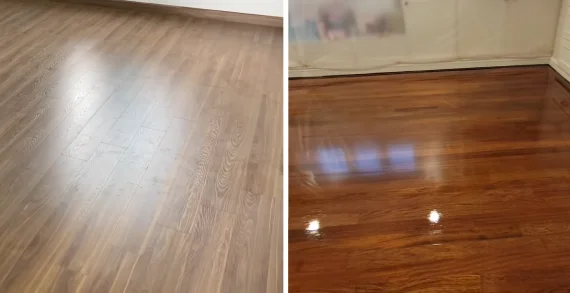
When choosing between natural and stained hardwood floors, there are several key factors to consider. Here are the main differences between natural and stained hardwood floors:
- No 01: Appearance
- No 02: Color and Variety
- No 03: Light Reflection
- No 04: Room Size Perception
- No 05: Durability and Maintenance
- No 06: Style and Design
- No 07: Cost
- No 08: Longevity
No 01: Appearance
The difference in appearance between natural and stained hardwood floors is significant. While natural hardwood floors showcase the inherent beauty of the wood, stained hardwood floors have a color applied to alter the natural appearance of the wood.
Here are some things to consider when deciding which type of hardwood floor appearance to choose:
- Natural hardwood floors have a more rustic and organic appearance. The natural grain and patterns of the wood are on full display, giving the space a warm and inviting feeling.
- Stained hardwood floors can provide a more modern and sleek look. The color of the stain can be customized to match the decor of the room and can create a more uniform appearance.
- Natural hardwood floors often have variations in color and texture, which can add character and charm to a space.
- Stained hardwood floors can be more consistent in color and texture, creating a more polished and refined look.
No 02: Color and Variety
If you’re looking for more options and a way to truly customize the color of your flooring, you’ll want to consider stained hardwood floors.
Unlike natural hardwood floors that come in a range of natural wood tones, stained hardwood floors offer a wider variety of colors, allowing for customization and the ability to match specific design preferences. Stained hardwood floors come in a range of colors that can match any color scheme.
The staining process allows for a uniform color distribution, which can help mask any imperfections in the wood or create a consistent look throughout a space. Stained hardwood floors offer not only more color options but also greater variety.
With natural hardwood floors, the options are limited to the species of wood, which can often limit the color and tone. Meanwhile, stained hardwood floors can be made from any species of wood, so you can choose the type and color of wood that suits your decor.
This variety allows for more creativity in design and can help make a space feel more unique and personalized. Whether you’re aiming for a classic, traditional look or a modern, contemporary feel, stained hardwood floors can help you achieve it.
No 03: Light Reflection
A bright and spacious room atmosphere can be enhanced through the light-reflecting properties of hardwood flooring. Natural hardwood floors are particularly effective in creating this effect.
They reflect light well, making smaller rooms appear larger and brighter. This is because natural hardwood floors have a smooth and glossy surface that allows light to bounce off and spread out evenly.
As a result, the room feels more open and airy, which is perfect for those who want to create an inviting and welcoming space.
If you prefer a warmer and more intimate ambiance, stained hardwood floors may be a better option for you. Unlike natural hardwood floors, stained hardwood floors may absorb some light, creating a cozy and comfortable atmosphere. This is particularly useful for larger rooms that may feel too open and cold.
But it’s important to note that the amount of light that is absorbed depends on the color of the stain. Darker stains tend to absorb more light, while lighter stains tend to reflect more light. So if you’re looking for a balance between warmth and brightness, consider using a lighter stain that still allows for some light reflection.
No 04: Room Size Perception
When it comes to hardwood flooring, the size of your room can be perceived differently depending on the color and finish you choose. Natural hardwood floors can give the illusion of space in smaller rooms due to their light-reflecting properties, making the room appear brighter and more open.
On the other hand, stained hardwood floors can add depth and richness to larger rooms, making them look more cozy and intimate.
To better understand how the color and finish of hardwood floors can affect the perception of room size, consider the following table:
| Room Size | Natural Hardwood Floors | Stained Hardwood Floors |
| Small | Create an illusion of spaciousness | Add depth and richness |
| Large | It can make the room appear too bright and open | Create a cozy and intimate atmosphere |
No 05: Durability and Maintenance
Maintaining the appearance of your hardwood floors over time requires regular care and attention, including proper cleaning and refinishing every few years.
While both natural and stained hardwood floors are durable, stained floors may require more frequent maintenance to retain their appearance. This is because scratches and imperfections are more visible on a stained floor than on a natural one.
To keep your stained hardwood floors looking their best, it’s important to clean up spills immediately and avoid using harsh chemicals or abrasive materials that can scratch the surface. Regular sweeping and vacuuming can also help prevent dirt and debris from accumulating and causing damage.
Refinishing every few years can help restore the shine and color to your floors and repair any minor scratches or dents that may have occurred.
No 06: Style and Design
If you’re looking for a classic and timeless look in your home, hardwood floors offer a versatile design option that can suit any style. Natural hardwood floors offer a warm and inviting feel with their unique natural patterns and colors.
They can give your home a rustic or traditional look that is perfect for those who prefer a more organic feel in their living space. Natural hardwood floors also provide a sense of authenticity, as they’re made from real wood that’s been carefully selected and crafted.
Alternatively, stained hardwood floors provide a wider range of design options, allowing you to match your existing decor or create a new look altogether. Stained floors come in a variety of colors and shades, from light to dark, and can be customized to fit your specific design preferences.
They can provide a modern or contemporary look that’s perfect for those who prefer a more sleek and polished aesthetic.
No 07: Cost
Natural hardwood floors are generally more cost-effective than stained floors because they require fewer additional materials and labor for staining and finishing. When it comes to cost, there are a few things to consider. Here are some factors that can impact the cost of natural and stained hardwood floors:
- Type of wood: Certain types of wood, such as exotic species, may cost more for natural hardwood floors.
- Stain color: Choosing a specific stain color can significantly impact the cost of stained hardwood floors.
- Additional materials: Stained hardwood floors may require additional materials such as wood filler, sealer, and topcoat.
- Labor costs: The labor costs for staining and finishing hardwood floors can be quite high, depending on the complexity of the job.
No 08: Longevity
Natural hardwood floors may require more maintenance, but they have the potential to last for decades. They can be sanded down and refinished multiple times, giving them a new lease on life.
On the other hand, stained hardwood floors may not have the same longevity as natural hardwood floors. The stain can wear off or become dull over time, especially in high traffic areas.
But, it’s important to note that the longevity of hardwood floors also depends on how well they are cared for. Regular sweeping and mopping, as well as avoiding harsh chemicals and excessive moisture, can extend the life of both natural and stained hardwood floors.
Should I paint or stain my hardwood floors?
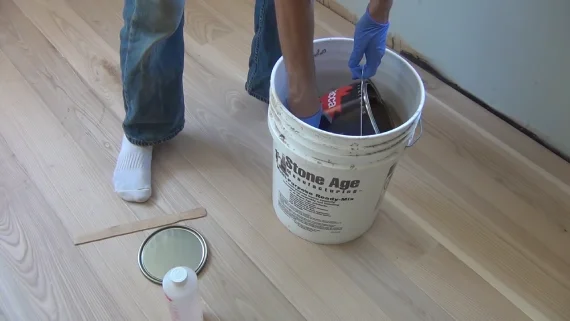
Consider painting your hardwood floors instead of staining them, as painted floors are easier to maintain and can be reapplied with a fresh coat of paint when needed. While stained floors can look beautiful, they require more upkeep as the stain can wear off and scratch easily.
Painted floors are more durable and resistant to wear and tear than stained floors. They can be easily touched up with a new coat of paint, while stained floors need to be completely sanded down and restained.
Painting your floors can give you more options in terms of color and design, as stains are limited in their color range.
Why do people like original hardwood floors?
You’ll fall in love with the charm and character of original hardwood floors, like a warm embrace from an old friend. There’s something about the natural grain and color variations that make them stand out from any other type of flooring.
Plus, they’re known for their durability and longevity, so you know you’re investing in something that will last for generations.
But it’s not just about appearance and longevity. Original hardwood floors are also hypoallergenic, which means they won’t trap dust and allergens like carpeting can. This makes them a great choice for anyone who suffers from allergies or asthma.
And because they’re made from natural materials, they’re also a more environmentally-friendly option than synthetic flooring materials. When you choose original hardwood floors, you’re making a choice that’s both beautiful and responsible.
Are stained wood floors better than natural wood floors?
Now that you understand why some people prefer the original look of hardwood floors, let’s explore the benefits of stained flooring.
Staining your hardwood floors allows you to customize the look of your space to fit your personal style. With a variety of stain colors available, you can choose a shade that complements your furniture, walls, and overall design aesthetic.
Stained hardwood floors also tend to offer more warmth and character than natural floors. By accentuating the wood grain, the stain adds depth and texture to your floors. This can create a cozy atmosphere in any room, making it feel more like a home.
Accordingly, while some may prefer natural hardwood floors, stained flooring offers more flexibility and the opportunity to truly make your space your own.
Natural or Stained Hardwood Floors
In the realm of hardwood flooring, the choice between natural and stained options is a matter of personal style and the desired impact.
Natural hardwood floors embody a timeless traditional design, with their ability to reflect light and create an illusion of spaciousness in smaller rooms. They are cost-effective, easy to manage, and require minimal maintenance.
On the other hand, stained hardwood floors offer versatility, allowing for customization with a vast array of stain colors and designs. While they may require more frequent maintenance, stained floors can transform the look of common hardwood species and create a unique ambiance.
Ultimately, whether one opts for the classic elegance of natural hardwood or the trendy allure of stained hardwood, both options provide a beautiful finish that adds warmth and character to any space.


